
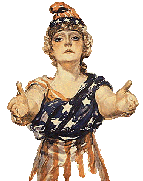
Exploring our past to sort out myth from reality
Share this Page on
Facebook or Twitter

These are the voyages of the TimeShip Anachron.
Our Mission: To boldly explore the past, dispelling
mythinformation and mythconceptions
of American History along the way.
 Visit us on Facebook
Visit us on Facebook
Meet MythAmerica Series

Part 1 Part 2 Part 3 Part 4 Part 5
Uncle Sam’s Kids, Part 3
“Xtry, Xtry, Read All About It!”
The first time I saw a “newsboy cap” was in a comic book when I was a young girl in the early 1950s. My hero was the spunky Little Lulu, and I started reading her comic books before I even went to Kindergarten. No, Lulu Moppet didn’t wear a newsboy cap—hers was more like a beanie. Nor did her boyfriend Tubby (Thomas) Tompkins, whose constant headgear was a sailor hat much too small for his head.
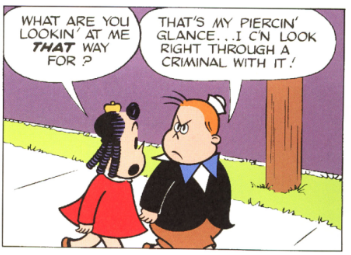
It was one of Tubby’s friends in his Clubhouse Gang who wore a newsboy cap.

No, it was not Eddie Stimson, the blond who had a “Jughead” style pointy-
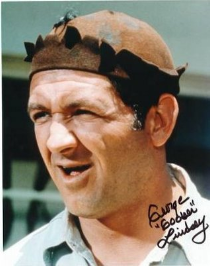
No, the one with the newsboy cap … and the knickers (knee-

The Lulu comic had originated clear back in 1935, and until very late in the run of the comic books, the clothing styles worn by everyone in them harkened more back to the 1930s and 40s. For instance, Tubby always wore “short pants,” and it was made clear in the story line that there would come a time when he would get his first pair of “long pants” as a sort of “rite of passage.” I started grade school in Dayton, Ohio, in 1952. At that point in time, I saw one boy in the whole grade school who wore short pants. (Different from casual “shorts” in summer—those were an entirely different clothing item.) I never saw another boy in short pants from that point on in time. And I also never, ever saw a boy wearing knickers to school. (I never even heard the name until the mid-
The same is true of hats. I don’t ever remember seeing a boy wear any kind of hat for “everyday wear” from the time I started school until I graduated, other than a baseball cap or a cowboy hat. But again, this was not so in the 1940s and earlier. Up until about 1950, almost all men and boys wore some kind of hat when outdoors, all the time, year around.
Actually, it’s only been in the last decade or so that there has been a resurgence in the popularity of headwear among males…and females…for everyday wear. And that resurgence has included, for both men and women, a surprising popularity for the “newsboy cap.” It’s become quite the fashion statement even on unexpected heads.

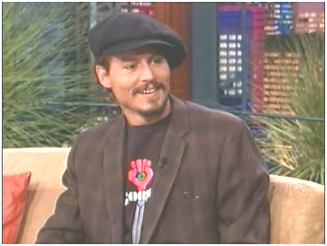
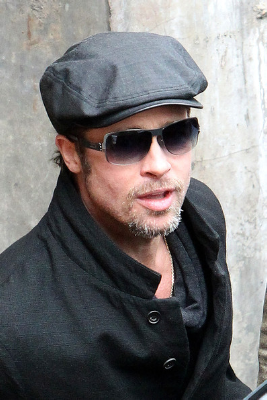

For a time I wondered why it was called a “newsboy” cap. I remembered newspaper boys from my youth. Nowadays most newspapers delivered to homes of subscribers daily in towns and cities are delivered by adults driving vehicles But back in the 50s and 60s (and no doubt for some time later) they were delivered by pre-

It was one of the few “jobs” a young man of that age could get to supplement his allowance. If the local paper was a morning paper, he would have to get up real early to deliver all his papers on his route before heading out to school—not easy for those who were “night people.” He’d also have to make extra trips to collect payment for the newspaper subscriptions. If he wanted to keep his job, he had to make a certain amount of sacrifice, including going out even if it was raining or snowing (in that case, many suburban parents would often step in and agree to drive him around his route in the family station wagon so he wouldn’t catch a cold.) And if he was diligent, even though he wouldn’t get rich, he could save up to buy himself special items such as a nicer bike or sports equipment. Or maybe treat a young lady friend to a sundae at the Soda Shop on weekends.
But in all my years since I was a young child, I’d never seen a newspaper delivery boy wear anything but a baseball cap. So what’s with the Newsboy Cap?? It was typically worn by THIS kind of newsboy shown below, who didn’t deliver newspapers to subscribers in peaceful suburbs from a Schwinn bike. And as you will see, even though Clooney and Pitt and Depp wear their Caps as a fashion statement, they were far from a fashion statement back in the day.

Newspaper boys, also called “newsboys” or “newsies”, were the main distributors of newspapers to the general public from the mid-
They were not employees of the newspapers but rather purchased the papers from the publishers and sold them as independent agents. Not allowed to return unsold papers, the newsboys typically earned around 30 cents a day and often worked until very late at night. Cries of “Extra, extra!” were often heard into the wee hours of the morning as newsboys attempted to hawk every last paper.
Newsboys were not often well received. In 1875 a popular writer of the period wrote, “There are 10,000 children living on the streets of New York….The newsboys constitute an important division of this army of homeless children. You see them everywhere…. They rend the air and deafen you with their shrill cries. They surround you on the sidewalk and almost force you to buy their papers. They are ragged and dirty. Some have no coats, no shoes, and no hat.”
However, the common ill-
Most newsboys of this type—down to as young as five years old—were either from extremely poor families, or homeless “street kids.” They didn’t work to “supplement” a non-
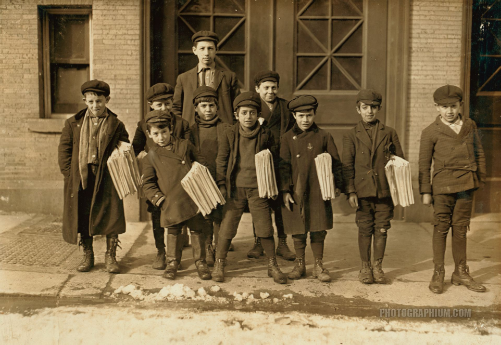
Small Hartford newsboys. Some are 7 and 8 years old.
Many more as small. Hartford, Connecticut. 1909 March. [Hine]

Tony Casale, age 11, been selling 4 years.
Sells sometimes until 10 p.m. His [supervisor] told me the boy
had shown him the marks on his arm where
his father had bitten him for not selling more papers.
He (the boy) said, “Drunken men say bad words to us.” Hartford, Connecticut. [Hine]

Michael McNelis, age 8, a newsboy [with photographer Hine].
This boy has just recovered from his second attack of pneumonia.
Was found selling papers in a big rain storm. Philadelphia, Pennsylvania. [Hine]

Out after midnight selling extras.
There were many young boys selling very late.
Youngest boy in the group is 9 years old. Harry, age 11,
Eugene and the rest were a little older. Washington, D.C. [Hine]
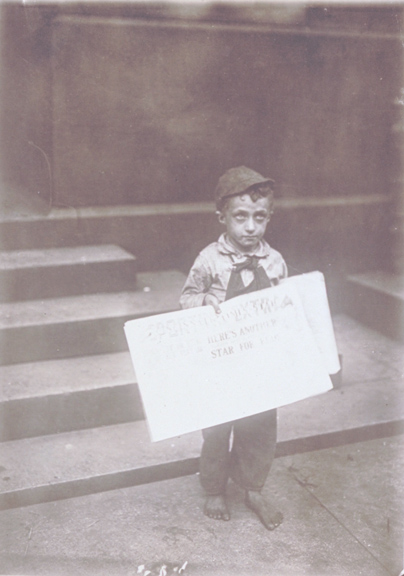
Young [barefoot] newsie working, pathetic story. 1908 [Hine]

Newsboy asleep on stairs with papers. Jersey City, New Jersey. [Hine]

Francis Lance, 5 years old, 41 inches high.
He jumps on and off moving trolley cars at the risk of his life. St. Louis, Missouri. [Hine]
No, these young men were not “livin’ the American Dream.” And most never grew up to live it either, in spite of the promise of all the “rags to riches” hype in the pre-
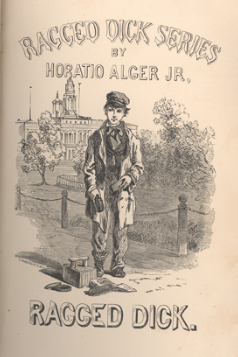

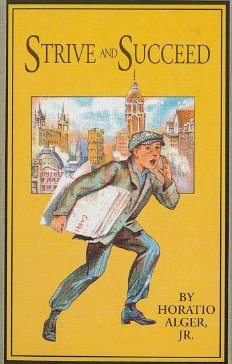
Horatio Alger’s famous, pompous fiction in which street boys make it good just by being diligent and honest…well, and with a WHOLE lotta luck and getting just the right “mentor” and “benefactors” at just the right moment…wouldn’t logically have been aimed primarily at the little boys shown above anyway. Many if not most of those lads had little if any schooling, read poorly if at all…and even if they could, could scarcely have been expected to “get” Alger’s many allusions to the Bible and Shakespeare, Milton and Cicero that he peppered his books with!
And even if they could read, few could likely have afforded the books. The books were no doubt most popular with middle class children as “entertainment,” and were probably approved by middle class parents particularly because they encouraged boys to strive for middle class values. I guess they might have not been quite as approving if they had known about the little … incident … early in author Alger’s career.
At the time, shortly after the war in 1866, Alger was working as a Unitarian minister, having followed in his father’s footsteps, in Brewster, Mass., but was forced to resign — and to move out of town to New York City — after being accused of “the abominable and revolting crime of unnatural familiarity with boys,” as put in a letter from congregation leaders detailing the incident to the American Unitarian Association in Boston.
According to Brewster Revisited by Bill and Mary Roach, church officials said Alger was accused of engaging in unnamed sex acts with 13-
The church documents also suggested that there may have been other boys with whom Alger was involved, but these were the only cases that came before the church’s investigating committee, to which Alger did not confirm or deny the charges but only admitted he had acted “imprudent” — although the cases were never brought before the full parish committee for a hearing that would have included witness testimony. [Source]
Did at least some of those in the ranks of the newsies escape their poverty eventually, and move up to a respectable middle class life? I don’t doubt that at all. But I’m not convinced that makes up for the destroyed childhoods of so many—caused in great part because of the greed of those captains of industry who kept the parents of these children… if they had any…working at slave labor wages in sweatshops and mills and mines so that they absolutely had to rely on whatever pennies the grinding efforts of their children might bring in.
But of course maybe the answer is that this was only “the natural way God intended for the poor.” That seems to have been a common view in both the UK and the US for many a long year until very recent times.
It is easy to interpret the outraged activism of writers like Dickens as indicative of a transformation in public sentiment about children. But such protests were fuelled by the fact that many people still believed that children did not need to be shielded by the state from adult responsibilities. Queen Victoria’s husband Prince Albert spoke for many when he argued that the working man’s children were “part of his productive power,” an indispensable source of family income.
…What explains the sluggish pace of reform? The rise of industrial capitalism created a huge demand for cheap labor, which children certainly were. Responding to this boom, Victorian economists and politicians embraced a laissez-
I do see the hand of Satan stirring the pot in the matter of the incredible abuses of child labor throughout our history, and the blindedness of most people to its reality in their midst. But his hand was not at work among the “ragged, dirty children” such as that little one above passed out on the steps on his pile of newspapers. It was at work among the filthy rich adults, eager to squeeze the most work out of the helpless, the most profits out of the blood, sweat, and tears of the poor. And it was at work blinding the middle class masses to their own callousness…and satisfaction to have “the lowest prices” … at any price, no questions asked, no accountability required.
But maybe the newsies of the big cities and the kids in the coal mines and mills were an aberration, we might speculate? Just tiny pockets of a lingering problem that was well on its way to solution as the 20th century dawned?
Surely Americans, so proud of life, liberty, and the pursuit of happiness, so proud of their nation’s “prosperity” seen by the whole world, so proud of the American Dream that Lady Liberty promised the tired, poor, huddled masses swarming in from Ellis Island…surely they can’t have allowed this to be a wide-
In a “Christian nation” (as many in modern times have insisted the US was from its founding)? Where hymns about Jesus could still be sung by school choirs at Christmas and Easter concerts? Where every town could still have government-
Surely such a nation, over a century after its founding, couldn’t still be … blatantly ignoring, individually and collectively, the numerous admonitions in that Bible about not oppressing and not neglecting the poor. Could it?